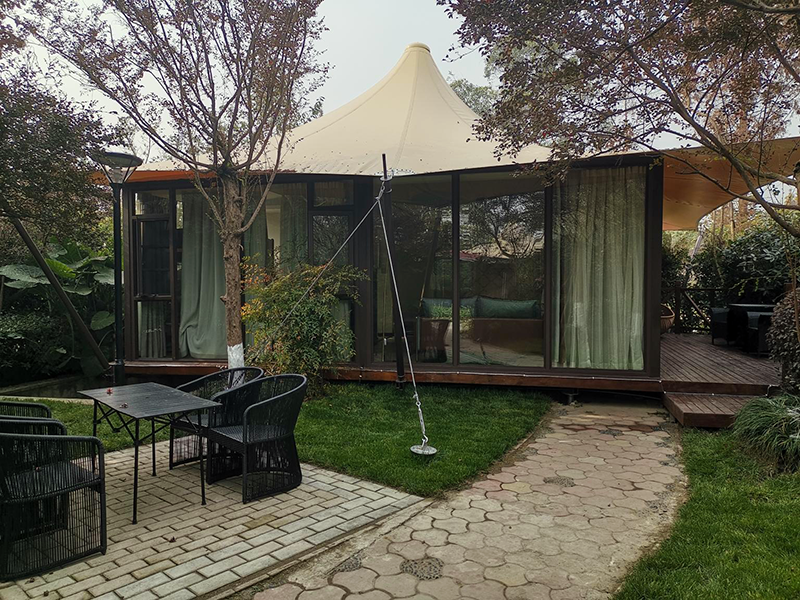Jan. 07, 2020
Like any other business, the glamping business can be divided into franchise, corporate and private ownership. In previous years, the glamping business was operated according to one or more of these models. But in recent years, some changes have occurred in the glamping business, and some new business models have emerged. This article covers the most commonly used and feasible glamping business models.

As you’re probably already aware, this business arrangement involves an existing established brand selling a license to a third party – person or company. This third party then trades and operates under their brand name and logo, employing their prescribed model of operation. It’s a very common model and our high streets, shopping centres and motorway service stations are full of them.
One such glamping franchise model operates to the standard format – it requires the landowner to pay an initial fee, to buy a minimum number of their structures, and pay an ongoing monthly commission. In return, the franchisee landowner can operate under the company’s trademarked name and logo, is provided with a website and booking system, and receives ongoing support from the franchisor. For example,Wigwam Holidays.
Another franchise model offers the same, however it doesn’t require an initial fee or the compulsory purchase of structures, but there is a trade-off in commission. If the landowner buys the structures they pay the franchisor a much lower commission than if the franchisor had provided them. To be considered for this kind of franchise, both land and landowner must meet a strict list of qualifying criteria. For example, Featherdown Farms, Lanterns & Larks.
In all cases the landowner is responsible for on-site operations and change overs. A franchise is a good option for those who want to set up glamping but don’t have the time or resources to go through the whole process, or don’t want to invest in structures and glamping outright. Terms and a minimum lease period will apply.
These are usually owned by very large businesses or corporations, and involve high numbers of units, with the same (or very similar) design scheme throughout. Features such as club houses, restaurants, pools, activities, gyms and spa facilities, are essential to this model. Given the multi-million pound level of investment in these developments, a high unit count plus strong ancillary revenues are the only way to ensure viability and deliver a sufficient return. For example: Love2Stay in Shropshire.
The majority of dedicated glampsites in the UK are privately owned by individuals, couples or families who had land and decided to diversify, or have purposely bought land to start a glampsite. This is the original small-scale, grass-roots glamping format, and can obviously incorporate any number of the models of operation as listed below.
Both resort and private glampsites can incorporate one or more of the following models of operation, (for franchises, not so much, it depends on the lease agreement):
Lifestyle – Most small, privately-owned sites offer this, where guests are immersed in an experience that is unique to that site, and the owners themselves play a big part of this. They are usually carefully and thoughtfully created by owners who are passionate about their location and whatever it is they do there – be it a craft, farming or other vocation. Can also include other models in this list.
Events – festivals and wedding receptions are ever popular, some sites are also obtaining licenses to conduct the wedding ceremony itself. Events require planning applications and licensing according to party size, entertainment etc.
Wellness – as I’ve mentioned in previous pieces, health and wellbeing is a fast-growing leisure sector. From yoga to raw food workshops, it’s the perfect partner to glamping.
Sports and activities – again, another growing leisure sector providing ample opportunity to add a USP or additional revenue streams to the business.
Learning and education – the rural locations of glampsites lend themselves perfectly to hosting and running courses and workshops on a variety of related subjects.
Corporate hospitality – more suited to larger developments perhaps, but some smaller operators also cater to the corporate market, offering team building and stress management courses. Standards need to be high, and each delegate will usually want private accommodation and facilities.
Service – this type of glamping takes hospitality to another level, providing a service-focussed offer usually only found in exclusive hotels.
Boutique – this glamping model can include some of the above, but its primary focus is to provide a highly individual and specialised offer to its guests.
Adults only – something of a niche, but I am seeing more glamping that does not accommodate children. While some sites cater predominately to families, I’m not sure that’s a model as such (most accept small groups or couples as well) although the ‘family safari tent’ set-up is getting close.
This is where an existing hospitality business diversifies its accommodation mix by adding glamping ie. campsites, holiday parks, public houses, B&Bs, hotels, resorts. For example, Hoseasons Pods, Haselbury Mill Hotel Somerset, The Camping & Caravanning Club’s ‘Ready Camp’andthe YHA.
I’ve advised owners of hotels and public houses on adding glamping to their existing accommodation and it always works well. They can accommodate more guests for events and weddings, and attract guests who wouldn’t otherwise have stayed. If you own such a business with suitable adjoining land, but haven’t added glamping yet – why not?
I was tempted to include ‘attractions’ in ‘supplementary accommodation’ but I think they should stand alone because their core business isn’t accommodation. In my head, historic properties and theme parks have a category of their own too, but then the principle of adding glamping to an existing attraction is the same whether it’s 500, or 15 years old. Glamping is a natural addition to these attractions, creating an enriched experience for visitors, encouraging longer stays and boosting revenue. The glamping should ideally have a design connection with the nature of the attraction and add interest – rather than a ‘bolt-on’. For example, Alton Towers’ Woodland Lodges and Warwick Castle.
Leasehold isn’t a new concept in holiday accommodation; many parks and caravan sites have been selling chalets and statics on long term leases for a long time. It is however new to glamping, where until now accommodation has been let for short breaks only. I’m not sure if this will catch on in the UK, but it’s already happening in Europe. What will it be next, time share? Remember you read it in Open Air Business first!
Unlike sited holiday glamping, this isn’t something I work on every day so there are better qualified people out there to expand on this. However, within an article on glamping business models they do require a mention. Under this header you’ll find:
Pre-ordered glamping, usually bell tents, erected at regular campsites by a third-party operator for guests, taken down at the end of their stay, and sometimes re-erected at another site for them. I’ve seen a few such operators come and go
Event glamping, where a village of glamping is erected for hire at events such as festivals and sports. For example, ‘Pop Up Hotel’ at Glastonbury Festival
Temporary event tipi and /or accommodations for weddings and guests, usually on private land
28-day pop-up glamping, where landowners are permitted to hold camping on their land for up to 28 days throughout the year.
Before I sign off I want to mention a few of the alternative set-up options that can apply to some of the above-mentioned models.
Site licence exemption certificate: Sites operating with an exemption certificate are usually run by private SMEs, and operate in the same way as any other site, with one exception – they did not have to apply for planning permission or a camping and caravan certificate from their local authority. This is because they have joined an organisation that has been set up in accordance with specific legislation, and operates to accepted responsibilities to promote rural leisure and recreation.
There are strict limitations on the number and type of structures (non-permanent) that can be used, and visiting guests usually also need to be members of the organisation. Usual planning rules will apply for additional facilities and groundworks. The traditional camping and caravan clubs are such organisations but they don’t support glamping sites, there are however a couple of ‘new kids on the block’ that are glamping friendly. For example, The Freedom Camping Club.
Rather than own the land I have also seen people lease it, and know operators who run successful glamping sites on this basis. However, I have also seen this model fail for various reasons – unreasonable lease agreements, excessive rental fees, inappropriate marketing platforms, poor communication/relationship with the landowner, to name a few. Most of these failures boil down to the absence of a business plan, particularly the financial forecast, which results in poor lease negotiations.
Also, one doesn’t need to buy the structures outright these days, because some suppliers now offer their tents and pods on a hire basis. Obviously, there are terms and a minimum lease period, but for those who don’t have the capital to invest, this does provide an alternative way to get going.
So, there you have it, I trust that I managed to herd the cats into some form of comprehensible legibility for you. As you can see, glamping is a fabulously flexible business option; we can create any number of types and styles to suit just about any hospitality enterprise.
Article Source: Business Models | openairbusiness.com

Chat Now